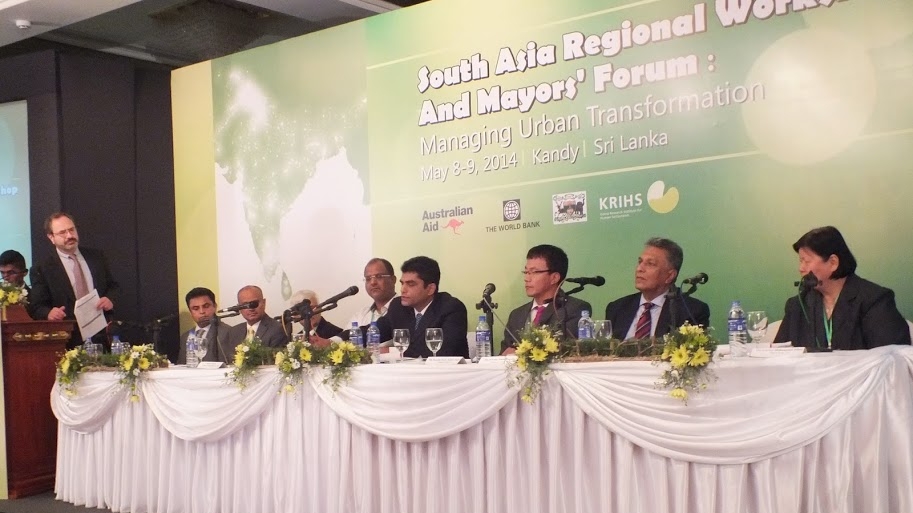South Asia’s urbanization phenomenon is increasingly gaining presence for social and economic mobility in urban areas, yet there are many opportunities within the region to leverage on-going urbanization process to boost prosperity and livability. The recently concluded South Asia Regional Workshop and Mayors’ Forum in Kandy Sri Lanka strongly brought out this message.
The last decade witnessed important demographic, structural, and spatial transformations occur across the region. South Asia's urban population has increased by about 130 million at the turn of the century. According to United Nations projections, 315 million more people will live in urban dwellings in the region by 2030. The inevitable nature of urbanization and the challenge of managing urban transformation was the theme of the Mayor’s Forum.
The two day forum brought together Mayors representing all South Asian countries, South Korea and Philippines, we asll we Deputy Ministers, Secretaries, members of academia and urban development practitioners. The Kandy Municipal Council together with the World Bank collaboratively organized this forum, sponsored by the Korea Research Institute for Human Settlements (KRIHS) and Australia AID.
Over the two days, the participants shared knowledge, experiences, challenges and effective practices in managing urban transformation.
Mayors’ Roundtable Discussion
The Mayor’s roundtable discussion brought out the key challenge faced by most mayors in South Asia: coping with a rapid urban and spatial transformation with limited capacity and resources.
The Mayors of Thimpu in Bhutan and Dagupan City in the Philippines shared their experiences fostering public support using new media and technology in managing urban transformation. Examples varied from creating space for the public to be better prepared for natural disasters and adapt to climate change calamities to creating jobs for urban youth.
Managing Urban Transformation
In her opening remarks, the World Bank Country Director for Sri Lanka and the Maldives, Francoise Clottes, identified that globally urbanization is inevitable. Urbanization, while creating opportunities and space for innovation to take off, also adds pressure on the land, environment, housing and other societal needs of the population. Managing urban transformation needs strong leadership. “Strong leadership is and will remain the key to manage urban transformation beneficial to all people without compromising the protection of the environment and societal needs. It is a difficult challenge,” she incited, inviting participants to exchange lessons, ideas and effective practices in order to support a better process of managing urban transformation.
Sharing lessons from Sri Lanka in his welcome speech, the host, Mahindra Ratwatte, elaborated the daily challenges he faces as the Mayor of Kandy. Kandy attracts many tourists, pilgrims and a daily half million floating population to access services, in addition to a population 120,000 residing in the city. As Mayor, he said he faced the following challenges on a daily basis: ncreasing density of the city’s living and daily migrant population; lack of space inside the city limits; tensions between increasing construction and the need to preserve the environment in harmony with the heritage status; necessity to modernize living and provide comforts to the stakeholders; road and rail network congestion; increasing demands for educational, health, residential, cultural, recreational and other activities; need for advancing the economy and increasing business profits. In addition, finding financing is a bigger challenge.
Agents of Transformation
“Growth, prosperity and livability” are cornerstones of sustainable urbanization said John Henry Stein, Sector Director for South Asia Sustainable Development at the World Bank. The urban population in South Asia Region has increased by 130 million, equivalent to the population of Japan. Mr. Stein remarked that while the South Asia region has made progress in reducing poverty and increasing shared prosperity, urbanization in the region is underleveraged. One main factor to stimulate this change is to unleash the potential of mayors. He noted that most mayrs who have come to their position were not concerned with political benefits. “They are concerned citizens wanting to make a change in how their cities are managed,” reported Mr. Stein based on his conversations with the regional mayors about their commitment to become agents of urban transformation.
This was the 4th South Asia regional conference on urbanization. Opportunities of urbanization, green growth, managing land and housing development were themes covered in previous conferences.
Read more and share your views here.
Last Updated: May 16, 2014

